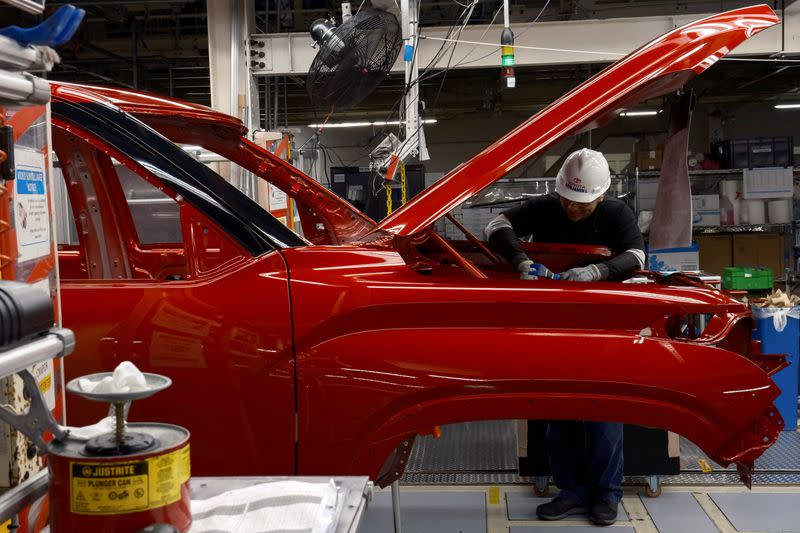(Reuters) – At Toyota Motor (NYSE:TM) Corp’s sprawling factory here, just 16 miles (26 km) from the Alamo, a new gasoline-fueled Tundra pickup truck or hybrid Sequoia SUV rolls off the assembly line every 60 seconds.
“We can’t produce enough of the Sequoias and Tundras today,” said plant manager Kevin Voelkel. “There is a waiting list.”
Less than two hours to the north in Austin, the Tesla (NASDAQ:TSLA) Inc Gigafactory is also straining to meet demand. That plant is ramping up output of Model Y electric SUVs and pushing to launch production of Tesla’s long-delayed Cybertruck that will compete with Toyota’s Tundra.
The two Texas factories represent what is at stake as U.S. President Joe Biden’s administration drives to lock in tougher vehicle emissions standards designed to push electric vehicles to 67% of the U.S. new car and truck market by 2032, from about 7% currently.
The Biden administration’s emissions proposals would give a powerful boost to Tesla, General Motors Co (NYSE:GM), Ford Motor (NYSE:F) Co and other automakers that have bet on an EV-dominated future.
Clamping down on combustion vehicle emissions will raise the cost of trucks like the Tundra. Billions in production and charging infrastructure subsidies should help make EVs cheaper and more desirable to consumers.
Toyota, the No. 2 automaker in the U.S. market by sales volume, has been outspoken in its skepticism of the administration’s EV goals – despite criticism from environmental groups.
“EPA’s proposal would effectively require two out of every three vehicles sold in 2032 to be battery electric. This target is ambitious and heavily reliant on factors outside the control of the auto industry,” Toyota said in a statement, referring to the U.S. Environmental Protection Agency. “Vehicle standards should help drive a level playing field that allows consumers access to a variety of clean vehicle and fuel options.”
TOYOTA’S PAST SUCCESS
Washington’s push to accelerate the shift to battery-electric vehicles amplifies the threat posed by Tesla to Toyota’s position as the world’s largest automaker.
Toyota displaced GM as the world’s top automaker in part because it pioneered a lower-cost, higher-quality lean production system that enabled it to build vehicles with fewer hours of labor and less capital investment. Toyota’s production system – based on continuous, often incremental improvements – is central to the work of the San Antonio truck plant’s 3,800 direct employees, as well as another 5,600 with suppliers on the same campus.
Toyota San Antonio has weathered a series of challenges since it built its first truck in 2006. But over the past decade, the factory has thrived as U.S. consumer preferences began to shift decisively in favor of trucks and SUVs.
Workers racked up overtime each day and one weekend day every week to keep up with demand. From 2016 through 2018, the plant produced more than its capacity of 208,000 vehicles a year.
Toyota invested almost $400 million to upgrade the assembly line to build refreshed 2022-model Tundras and Sequoias.
The Biden administration’s emissions standards now threaten to run large combustion and hybrid vehicles like the Tundra and Sequoia off the road.
THE TESLA THREAT
Tesla’s Austin factory represents another threat: Tesla CEO Elon Musk’s challenge to everything Toyota has accomplished since it first entered the U.S. market in 1958.
Tesla’s battery EVs do not run on fossil fuels – or use the sort of hybrid gas-electric technology Toyota champions in its Prius line.
Tesla is also challenging Toyota’s lead in lean production. Tesla builds Model Ys using large, one-piece “mega-castings” to create big chunks of the vehicle’s body structure. Mega-castings replace scores of metal parts Toyota and other manufacturers use to create vehicle bodies – along with the expensive machines that weld them together.
The floor of a Tesla Model Y is the top of the SUV’s battery pack – a design that yields a 14% gain in efficiency, said Terry Woychowski, president of Caresoft Global Technologies. Caresoft dissects and analyzes vehicles down to the nuts and bolts in a suburban Detroit workshop.
“The Tesla approach is very, very disruptive,” Woychowski said, standing near a Model Y that had been taken apart by Caresoft staff.
Tesla executives told investors in March they are working on a new approach to assembling vehicles that could cut production costs by half.
The future for factories like Toyota San Antonio will play out across the next several years.
The emissions targets the Biden administration proposed last week kicked off a months-long negotiating process among regulators, auto industry officials and climate action advocates.
Bargaining over the details of the rules will take place against the backdrop of the 2024 U.S. presidential campaign. Republicans are already attacking the proposed rules.
“The ‘electrification of everything’ is not a solution,” said U.S. Senator John Barrasso, the top Republican on the Energy and Natural Resources Committee. “It’s a road to higher prices and fewer choices.”
The future of the workers at Toyota San Antonio could also depend on how quickly and successfully Toyota develops EVs the plant can build.
“We will find a way,” said Voelkel, the plant manager. “We always rise to the occasion.”



